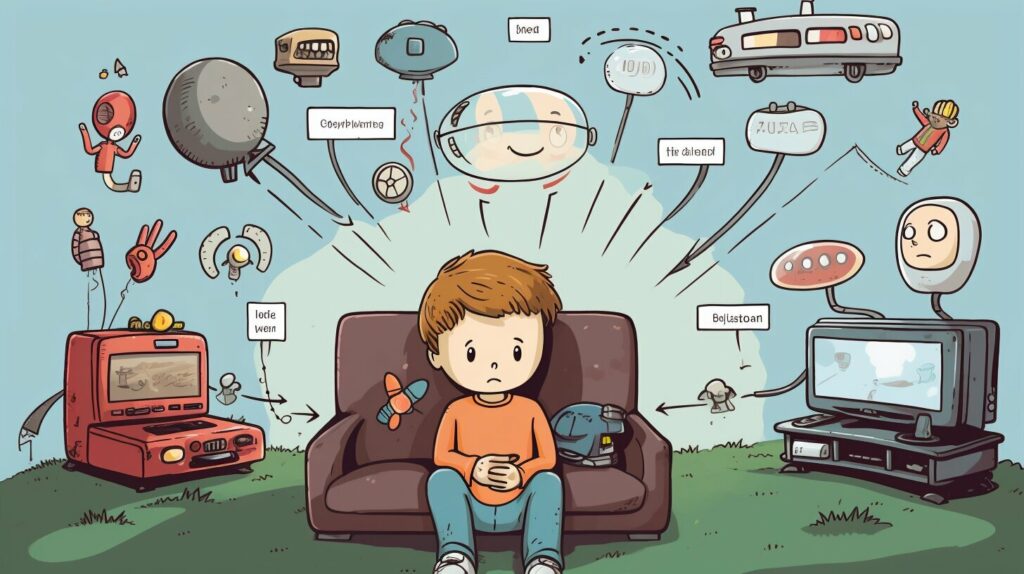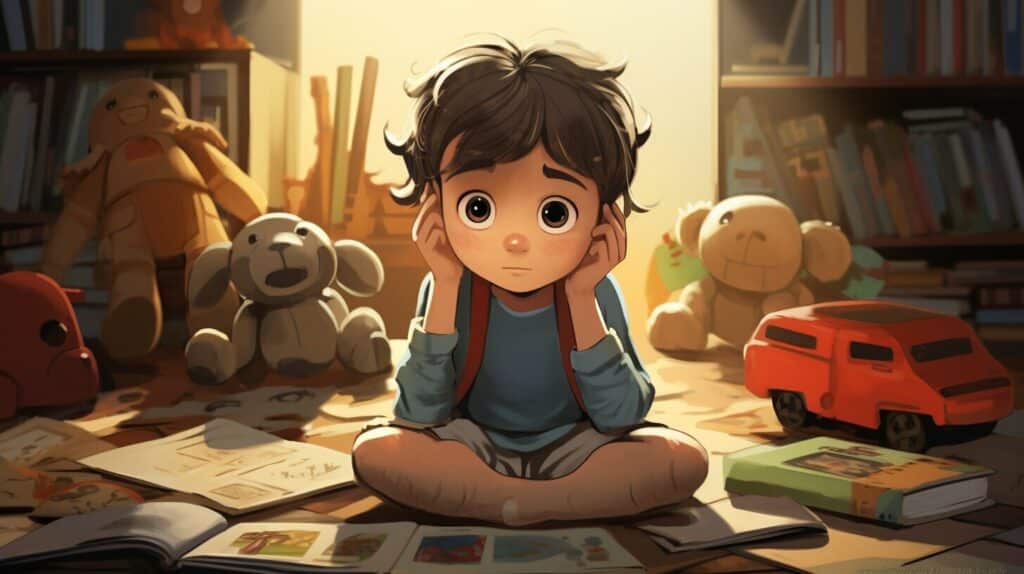As a parent or educator, you want to teach your child the value of making informed decisions. One way to do this is by explaining the concept of opportunity cost. This may sound complicated, but it’s really just a fancy way of saying that when you choose one thing, you give up the opportunity to choose something else.
For instance, if you choose to spend your allowance on a toy, you cannot spend it on a book. This is a simple example of opportunity cost, and it’s important for children to understand this concept early on.
In this article, we will provide you with fun and easy steps to teach your child about opportunity cost. By the end, your child will have a solid understanding of this valuable concept and be better equipped to make informed decisions.
Key Takeaways:
- Opportunity cost is the idea that when you choose something, you give up the opportunity to choose something else.
- Teaching children about opportunity cost can help them make better informed decisions.
- Through relatable examples and interactive activities, you can make teaching opportunity cost to children fun and engaging.

What is Opportunity Cost?
Before diving into how to explain opportunity cost to a child, it’s important to understand what opportunity cost is. Opportunity cost refers to the value of the next best alternative that must be given up in order to pursue a certain action or decision.
For example, let’s say you have $10 and you have to choose between buying a toy or a book. If you choose to buy the toy, your opportunity cost is the value of the book that you could have bought with that $10. On the other hand, if you choose to buy the book, your opportunity cost is the value of the toy that you could have bought with that $10.
Opportunity cost is a concept used in decision-making in everyday life, from choosing what to eat for breakfast to deciding which college to attend. By teaching children about opportunity cost, they can learn to make more informed decisions and understand the consequences of their choices.

Why Teach Kids About Opportunity Cost?
Teaching children about opportunity cost may seem like a complex concept, but it can benefit them greatly in making decisions throughout their lives. By understanding how to weigh the costs and benefits of different choices, children can make informed decisions that lead to better outcomes.
Opportunity cost is the value of the next best alternative that an individual must give up in order to pursue a certain action. By teaching this concept to children, they learn that every decision has an opportunity cost, and they must choose the option with the highest benefit or value.
Why is it Important to Teach Kids About Opportunity Cost?
Teaching kids about opportunity cost is important for several reasons:
- Develops critical thinking skills: Understanding opportunity cost helps children think critically about the choices they make and the consequences of those choices.
- Encourages responsible decision-making: By weighing the costs and benefits of different options, children learn to make responsible decisions that lead to better outcomes.
- Prepares for future financial decisions: As children grow up, they will need to make many financial decisions. Understanding opportunity cost can help them make informed choices and avoid unnecessary expenses.
- Builds life skills: The ability to make informed decisions based on opportunity cost is a valuable life skill that can benefit children in many areas of their lives, from academics to personal relationships.
By teaching children about opportunity cost, you are setting them up for success by providing them with a valuable skill that will benefit them throughout their lives.

Explaining Opportunity Cost in Simple Terms
Now that you understand what opportunity cost is, it’s time to break it down into simpler terms that your child can understand. Opportunity cost can be compared to a trade-off. Think of it like this – if you have a dollar and you want to buy a candy bar for 50 cents, you won’t have that dollar anymore. You can’t buy something else with that same dollar because you already spent it on the candy bar. So the opportunity cost of buying the candy bar is not being able to buy anything else with that dollar.
Another way to explain opportunity cost is by using a real-life scenario. Let’s say your child has a choice between going to the park with their friends or staying at home to watch a movie. If they choose to go to the park, the opportunity cost is not being able to watch the movie. On the other hand, if they choose to watch the movie, the opportunity cost is missing out on the fun at the park with their friends.
Opportunity cost is all about making decisions and weighing the pros and cons of each choice. By teaching your child about opportunity cost, you are helping them develop critical thinking skills that will benefit them throughout their lives.

Now that you have explained opportunity cost in simple terms, it’s time to move on to the next section and understand how to make it more relatable with examples.
Understanding Opportunity Cost with Examples
To help your child grasp the concept of opportunity cost, it can be useful to provide relatable examples and scenarios that they can understand. Here are a few examples:
| Action | Opportunity Cost |
|---|---|
| Your child chooses to watch TV instead of doing homework | The opportunity cost is the potential good grade they could have received if they had completed their homework instead of watching TV. |
| You choose to go to the park instead of the movies | The opportunity cost is the potential enjoyment you could have received from watching the movie instead of going to the park. |
These examples illustrate how making one choice means giving up the benefits of another choice. By highlighting the trade-offs involved in decision-making, children can develop a deeper understanding of opportunity cost.
Another way to help your child understand opportunity cost is to use hypothetical scenarios. For example, if your child has $5 to spend at the store and they must choose between buying a toy or candy, have them think about the opportunity cost of each option. Would they rather have the toy and miss out on the candy? Or would they rather have the candy and miss out on the toy? By weighing the costs and benefits of each option, your child will begin to understand the concept of opportunity cost in a practical way.

Real-Life Applications of Opportunity Cost
Understanding the concept of opportunity cost is crucial for decision-making. By considering the cost of one choice over another, children can make informed decisions that lead to better outcomes. Here are some real-life examples that can help children grasp the concept better:
| Scenario | Opportunity Cost |
|---|---|
| You have $10 to spend at the amusement park. You can either buy a soda for $5 or an ice cream for $7. Which one would you choose? | The opportunity cost of buying the soda is not being able to buy the ice cream. |
| You want to go to the park to play but it’s raining outside. You can either stay indoors and watch TV or read a book. Which one would you choose? | The opportunity cost of watching TV is not being able to read a book. |
By explaining opportunity cost in terms of relatable scenarios, children can understand the concept and apply it to their daily lives. It can help them prioritize their choices and make better decisions.

Making the Concept of Opportunity Cost Engaging
Teaching children about opportunity cost doesn’t have to be a boring lecture. In fact, you can make it engaging and fun for them!
Use Games
Children love games, and using them to teach about opportunity cost can be effective. Try playing a game of “Would You Rather?” where they have to choose between two options and explain why they made that choice. This will help them understand that choosing one option means giving up the other. Another game you can play is “Trade-Offs,” where they have to negotiate and make choices based on limited resources.
Go on Field Trips
Take your child on outings and point out the opportunity cost of each decision. For example, if you decide to go to the zoo, you won’t have time to go to the park. This will help them understand that every decision has an opportunity cost. It also makes learning more fun and interactive.
Make it Personal
Children are more likely to understand and remember a concept when it is relatable. Use real-life scenarios that they can relate to, such as choosing between buying a toy or saving money for a future purchase. This will help them see the practical applications of opportunity cost in their own lives.
Use Visual Aids
Visual aids are a great way to make the concept of opportunity cost more engaging. Use charts, diagrams, and images to help illustrate the concept. For instance, you can use a simple table to show the opportunity cost of choosing one option over another.

Get Creative
Use your creativity to come up with fun ways to teach opportunity cost. For example, you can create a play or skit that demonstrates the concept. Or you can have your child create a comic book or story that incorporates the concept of opportunity cost.
Teaching opportunity cost to children can be an enjoyable and rewarding experience. By using these tips and ideas, you can make it engaging and memorable, helping your child make better decisions in the future.
Simplified Explanation of Opportunity Cost
When we talk about opportunity cost, we mean the value of the things you give up when you choose one option over another. For example, let’s say you have $10 and you’re trying to decide between buying a toy or a book. If you choose to buy the toy, the opportunity cost is the book you could have bought with that $10 instead.
To put it simply, opportunity cost is about making choices and understanding that choosing one option means giving up the other. It’s important to teach children about opportunity cost so they can make informed decisions and understand the consequences of their choices.
Think about the last time your child had to make a decision – maybe it was choosing between playing video games or going outside to play. By explaining the concept of opportunity cost, you can help them understand that choosing to play video games means giving up the opportunity to enjoy the outdoors.

The Importance of Understanding Opportunity Cost
Teaching your child about opportunity cost is crucial for their decision-making skills and personal development. By understanding opportunity cost, children can learn to weigh the pros and cons of each option and make informed decisions that take into account the value of what they are giving up. This will serve them well in all aspects of life, from financial planning to time management, and help them become responsible and thoughtful individuals.
By providing clear and concise explanations of opportunity cost and reinforcing the concept through fun and interactive activities, you can help your child develop strong decision-making skills that will benefit them for years to come.
Interactive Activities for Teaching Opportunity Cost
Teaching opportunity cost to children can be a fun and interactive experience with the right activities. Here are some ideas to get you started:
1. Role-playing games
Role-playing games can be an effective way to teach children about decision-making and opportunity cost. Give your child a scenario with multiple options and ask them to make a decision based on which option they think is the best. Next, ask them to identify the opportunity cost of the alternative they did not choose.
2. Lemonade stand
Help your child set up a lemonade stand and ask them to make decisions about pricing, inventory, and marketing. Encourage them to think about the costs and benefits of each decision they make, and how it will impact their profits. This will help them understand the concept of opportunity cost in a real-world context.
3. Budgeting exercises
Give your child a set amount of money and ask them to decide how to spend it. Encourage them to think about the trade-offs and opportunity costs of each decision they make. For example, if your child wants to buy a toy, they may have to give up the opportunity to buy a book.
4. Decision-making worksheets
Print out decision-making worksheets which present different scenarios and ask kids to make decisions based on weighing the costs and benefits of each option. These worksheets can help your child develop critical thinking skills and learn to consider the opportunity cost of their decisions.

Remember, the key to making these activities effective is to encourage your child to think critically and consider the trade-offs of their decisions. By helping your child understand the concept of opportunity cost, you can equip them with valuable decision-making skills that will benefit them throughout their lives.
Reinforcing the Concept of Opportunity Cost
Once you have explained the concept of opportunity cost to your child, it’s crucial to reinforce it in their daily lives. Here are some tips to help them understand and apply the idea:
- Encourage decision-making: Provide your child with different options and ask them to make a choice. Help them think through the pros and cons of each option and determine what they might be giving up by choosing one over the other.
- Use real-life examples: Point out examples of opportunity cost in everyday situations, such as choosing to spend money on a toy instead of saving it for a future purchase.
- Involve them in budgeting: Have your child help you create a budget for a family event or trip. This will help them understand that money is limited and that choosing to spend it in one way means giving up the opportunity to spend it in another way.
- Help them set goals: Encourage your child to set goals for themselves and think about the opportunity cost of their choices. For example, if they want to save money for a new game console, they may have to give up buying snacks from the vending machine at school.
By reinforcing the concept of opportunity cost, your child will develop critical thinking skills that will serve them well throughout their lives.

Conclusion
Congratulations! You now have a better understanding of opportunity cost and why it’s important to teach this concept to children. By providing a simplified explanation and relatable examples, you can help children grasp this important concept and use it to make better decisions in their daily lives.
Remember, reinforcing the concept of opportunity cost through interactive activities and real-life applications can help ensure that children retain this knowledge for the long-term. So don’t be afraid to get creative and make learning about opportunity cost fun!
Keep Learning!
There are many other useful concepts like opportunity cost that can benefit children’s decision-making skills. Keep exploring and learning with your child to help them develop valuable life skills that will serve them well in the future.

Can the Simple Approach of Explaining Budgets also be Used to Explain Opportunity Cost to a Child?
Explaining the concept of opportunity cost to a child can be approached in a similar way as explaining budgets. By using relatable examples and simple language, parents can help children understand that making choices involves giving up something else. Teaching the child how to explain budget to child is important for their financial literacy, as it equips them with invaluable decision-making skills at an early age.
FAQ
Q: How do I explain opportunity cost to a child?
A: Explaining opportunity cost to a child can be done in fun and easy steps. By breaking down the concept into relatable terms and using examples, children can understand the idea of making choices and understanding what they are giving up.
Q: What is opportunity cost?
A: Opportunity cost refers to the value of the next best alternative that is forgone when making a decision. It helps children understand that making a choice means giving up something else in return.
Q: Why is it important to teach kids about opportunity cost?
A: Teaching children about opportunity cost helps them develop decision-making skills and understand the consequences of their choices. It also prepares them for real-life situations where choices and trade-offs are inevitable.
Q: How can I explain opportunity cost in simple terms to a child?
A: You can explain opportunity cost to a child by using relatable terms and examples. For example, explaining that choosing to buy a toy means giving up the opportunity to buy a different toy or save money for another time.
Q: How can children understand opportunity cost better?
A: Children can better understand opportunity cost by providing them with relatable examples and scenarios. By showing them the trade-offs involved in different choices, they can grasp the concept more easily.
Q: How does opportunity cost apply to everyday situations?
A: Opportunity cost applies to everyday situations by helping children recognize the trade-offs they face in making decisions. It can be applied to choices related to time, money, and resources, teaching them to consider the value of alternatives.
Q: How can I make teaching opportunity cost engaging for my child?
A: You can make teaching opportunity cost engaging for your child by using interactive activities. For example, you can create a “choice jar” where they have to pick one item over another, understanding the concept of what they are giving up.
Q: How can I give a simplified explanation of opportunity cost to my child?
A: To give a simplified explanation of opportunity cost to your child, you can use examples that they can relate to and understand easily. By emphasizing the idea of making choices and understanding trade-offs, they can grasp the concept.
Q: What are some interactive activities for teaching opportunity cost?
A: There are several interactive activities you can try to teach opportunity cost to your child. For instance, playing “would you rather” games, conducting a mock store where they have to make choices with limited resources, or creating a budgeting game.
Q: How can I reinforce the concept of opportunity cost with my child?
A: You can reinforce the concept of opportunity cost with your child by incorporating it into their daily lives. Encourage them to consider the trade-offs of their choices and discuss the consequences of different decisions.
Q: What is a simplified explanation of opportunity cost for children?
A: A simplified explanation of opportunity cost for children is understanding that making a choice means giving up something else in return. It helps them realize that they have to consider the value of alternatives and the trade-offs involved.






